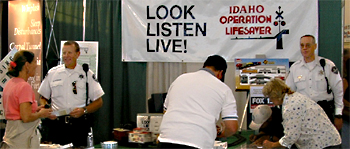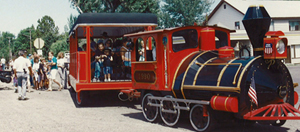
|
CONNECTIONS
|
IDAHO
ITD
HOME
IDAHO DMV
ITD
NEWS
HIGHWAY
SAFETY
IDAHO STATE
POLICE
TRAVEL SERVICES
STATE OF IDAHO
NATIONAL
AASHTO
AAMVA
AAA of IDAHO
FEDERAL HIGHWAYS
FEDERAL AVIATION
IDAHO STATE POLICE
NHTSA
NTSB
TRB
U.S. DOT
Idaho
Transportation
Department
Public Affairs Office
P.O. Box 7129
Boise, ID 83707
208.334.8005
Fax: 208.334.8563
Email


Operation Lifesaver brings rail/highway
safety messages to forefront
There’s a fine line – and a fraction of a second – that separates a vehicle/train collision from a vehicle/train fatality. It’s called luck, according to Chris Arvis.
The licensed train engineer from Pocatello has experienced 15 such collisions, involving too many fatalities, during his career. Although he still is licensed to operate locomotives, Arvis spends his days working to improve rail crossing safety through an concentrated educational campaign, better engineering and increased law enforcement.
As state coordinator for Idaho Operation Lifesaver, Arvis travels the state extensively delivering a rail safety and education program to audiences from preschool through retirement. The message is simple – always look before driving across rails and obey all laws regulating rail crossings. That includes rail-crossing devises such as flashing lights and cross arms.
He and a cadre of volunteers recently staffed an educational booth at the Western Idaho State Fair that reached about 18,500 people. The crowd was even larger at the Eastern Idaho State Fair that began Sept. 2 and concludes Saturday (Sept. 9) in Blackfoot. About 30,000 people were expected to visit the Operation Lifesaver booth this week.
A working model train attracts visitors to the booth. While there, individuals can watch a 30-minute public service video on railroad crossing safety. Arvis and his colleagues hand out safety information and brochures to adults and activity books to children. During both state fairs and the Spokane Interstate Fair, Operation Lifesaver teams with local television stations to give away model train sets to promote safety.
In addition to county and state fairs, Arvis and about 100 volunteers deliver more than 470 rail crossing safety presentations annually, reaching about 140,000 people.
 Occasionally
they use a custom-built street safety train to carry the message. The
train resembles a locomotive and coach car that seats about 30 people.
Occasionally
they use a custom-built street safety train to carry the message. The
train resembles a locomotive and coach car that seats about 30 people.
Beneath the façade, the engine is a modified tractor, similar to ones that move passenger planes and baggage trailers on airport tarmacs. Union Pacific Railroad built the street safety train for the Idaho Centennial celebration in 1990 and donated it to Operation Lifesaver seven years later.
“It’s one of a kind,” Arvis explains. “We’re lucky to have it… In other words, it’s irreplaceable.” It appeared at eight community events and a similar number of parades in 2005.
“We try to explain the potential danger that exists at highway/railroad crossings, how trains operate and the laws that govern railroad crossings,” Arvis explains. “We always try to encourage people to check the tracks before crossing and to obey the laws.”
Operation Lifesaver also calls on law enforcement to drive the safety message home. Officers from city, county and state jurisdictions ride in engines during targeted campaigns, watching for violations at highway crossings. They report offenders to fellow officers in nearby vehicles.
Ten officers-on-trains campaigns were conducted last year, and in a stretch between Pocatello and Idaho Falls more than 70 citations were issued.
The Operation Lifesaver program operates on annual budget of about $60,000. By legislative authority, $25,000 is provided through ITD’s Office of Highway Operations and Safety; Union Pacific contributes a like amount and the balance of the operating funds is provided by Idaho’s four short-line railroads.
 Arvis
also solicits grant funding to help with expenses.
Arvis
also solicits grant funding to help with expenses.
The three-part Operation Lifesaver campaign – education, enforcement and engineering – is producing tangible results.
“Ours is a pretty good success story,” Arvis says, pointing to a decade of statistics that show a steady decline in incidents, crashes and fatalities at Idaho highway/railroad crossings. He attributes that to dedicated volunteers who share his concern.
In 1991, when the safety campaign was relatively new, 66 collisions at railroad crossings accounted for 38 injuries and seven fatalities. Last year, the collisions dropped by nearly two-thirds to 21 incidents; six people were injured, but none fatally.
The five-year period (1991-1995) recorded an average of 7.2 fatalities and 24 injuries per year. During the following five years (2001-2005), the average number of injuries fell to 7.8 per year and deaths dropped to an average of 1.6.
Arvis said he will continue to coordinate OL campaigns “as long as we produce results and reduce the number of incidents and fatalities at highway/rail crossings.”
Photo: Operation Lifesaver coordinator Chris Arvis, center, manned a booth at the Western Idaho State Fair recently in Garden City.
Published 9-8-06